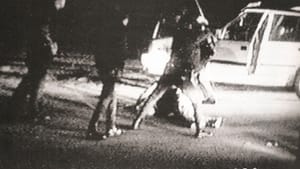Stay in the Loop
BSR publishes on a weekly schedule, with an email newsletter every Wednesday and Thursday morning. There’s no paywall, and subscribing is always free.
Can't we all just get along?
Blackstar Film Festival presents 'L.A. Burning: The Riots 25 Years Later'

In Langston Hughes’s famous poem "Harlem," he asks, “What happens to a dream deferred? Does it dry up like a raisin in the sun . . . or fester like a sore — And then run? . . . Maybe it just sags like a heavy load. Or does it explode?” The documentary L.A. Burning: The Riots 25 Years Later, directed by Erik Parker and One9, seems to answer Hughes’s questions by illuminating how a dream deferred for one becomes a dream deferred for many.
The Barnes Foundation, in partnership with the Blackstar Film Festival, presented the documentary, followed by a film discussion with Parker, on July 2, 2017, as part of Free First Sundays at the Barnes — just two days before the United States celebrated its independence. Ironically, some of the freedoms the Founding Fathers outlined in the Declaration of Independence — among them the statement that all men are created equal — are principles our country struggles to uphold 241 years later.
L.A. under fire
L.A. Burning is a poignant film highlighting the weeks leading up to the L.A. riots and their aftermath. The large-scale revolt ignited after Rodney King, a black taxi driver from South Central Los Angeles, was brutally beaten by white officers during a traffic stop in March 1991. When the officers responsible for the attack were acquitted more than a year later, people revolted.
“It wasn’t that Rodney was beat, it was that he got no justice for being beat,” Parker explained during the post-film discussion. “When someone feels they have no justice, that energy can be directed anywhere. The feeling of injustice is enough to make you go crazy . . . enough to make you want others to feel your pain.”
Like a boiling cauldron finally overflowing, angry protestors poured out of their homes and into the streets, scorching anyone and anything in their path. The film is embedded with video footage recorded by Tim Goldman, a resident who documented the riots on his personal camcorder. The footage was shaky and disorienting at times, but it thrust the viewer into the thick of the chaos.
For three days, there was complete pandemonium in Los Angeles: arson, looting, and ruthless attacks against innocent bystanders. According to the film, more than 50 people died, another 2,000 were injured, and an estimated 7,000 fires damaged more than 3,000 businesses and caused $1 billion in damages.
Untold stories
Although the documentary does a great job of recapping the gritty details of King’s story and the riots, the film does its most successful storytelling when magnifying the anguish of the unheard voices affected by the uprising. As Parker eloquently stated, “The goal of the film was to tell the story from the eyes of the people who saw it up close.” This perspective drives the narrative and invites viewers to become entangled in stories of others whose dreams were deferred.

Koreatown resident Sung Hwang is one of those voices. Hwang’s parents migrated from Korea to America in pursuit of the American dream. They worked hard and established businesses in the Koreatown section of South Central Los Angeles. However, during the riots, their dreams came crashing down as demonstrators plowed through their community, shooting, looting, and setting fires along the way, destroying everything Hwang’s parents had worked for. During the film, we follow Hwang’s journey back to the nail salon her mother owned as she relives the day the riot not only deferred their dreams, but robbed her family of its livelihood.
Twenty-five years later
At the end of L.A. Burning I walked away with a greater understanding of King’s story, the riots, and of the permanent imprint they left on the people in the community. But the film’s most striking, and probably most tragic, conclusion is that 25 years later the injustices King faced are the same injustices black victims of police brutality still face today. In the last six years, victims of police brutality, such as Eric Garner, Michael Brown, Tamir Rice, Walter Scott, Freddie Gray, Philando Castile, and their families have faced similar injustices. Protestors have also charged the streets in New York, Baltimore, and Ferguson, outraged over yet another acquittal of a police officer.
The fact that nothing has changed since the riots — and in many instances, things have gotten worse — leaves a bitter taste in my mouth. But I think that’s what the film means to do. As Parker noted, he hopes young people see L.A. Burning as a call to action and a vehicle to spur change in the legislature. As Parker stated, quoting hip-hop legend Tupac Shakur, “I’m not saying I’m gonna change the world, but I guarantee I will spark the brain that will change the world.”
What, When, Where
L.A. Burning: The Riots 25 Years Later. Erik Parker and One9 directed. Available on aetv.com.
Blackstar Film Festival, August 3 to 6, 2017, various locations. (267) 603-2755 or blackstarfest.org.
Barnes Foundation, 2025 Benjamin Franklin Parkway, Philadelphia. (215) 278-7000 or barnesfoundation.org.
Sign up for our newsletter
All of the week's new articles, all in one place. Sign up for the free weekly BSR newsletters, and don't miss a conversation.
 Jarreau Freeman
Jarreau Freeman